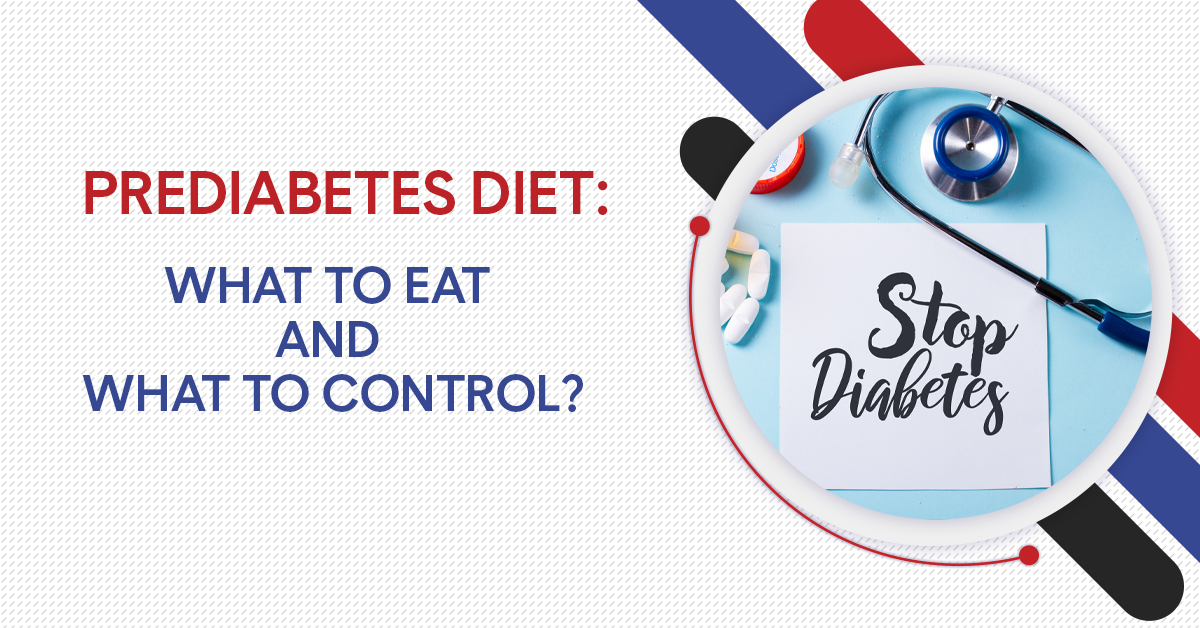What is Prediabetes?
The discovery of prediabetes can be concerning. The most common cause of this condition’s extremely high blood sugar (glucose) levels is insulin resistance. The body doesn’t utilize insulin adequately in this scenario. It frequently occurs before type 2 diabetes.
An elevated risk of type 2 diabetes exists in people who have prediabetes. You run the risk of getting the cardiovascular disease if you have prediabetes.
A prediabetes diagnosis, however, does not guarantee that you will develop type 2 diabetes. To get your blood sugar out of the prediabetes range, early action is crucial. You must be aware of the proper foods to eat to maintain a healthy diet.
Relation Between Prediabetes and Diet:
Your risk for prediabetes is influenced by numerous variables. If diabetes runs in your family, genetics may be a factor. However, dietary habits, inactivity, and being overweight are additional factors that are more important in the development of disease. You will feel lethargic if you consume a lot of food or sweets, and this condition increases your risk of developing prediabetes.
You Can Read Also: Pain in Arch of Foot: Causes, Stretches, Treatment, and Recovery
When the body either produces insufficient amounts of insulin or exhibits insulin resistance, which results in improper insulin utilization and a rise in blood sugar (glucose) levels, diabetes develops (hyperglycemia).
Because the body’s cells react to insulin incorrectly in prediabetes, the pancreas generates extra insulin to get the cells to function normally. When the pancreas eventually runs out of insulin to meet the body’s requirements, blood sugar levels increase.
How Is Prediabetes Diagnosed?
A blood test that measures fasting blood sugar levels is used to detect prediabetes. The table below includes ranges.
| Blood Sugar Category | Blood Sugar Level |
| Normal | less than 100 mg/dl |
| Prediabetes | 100 mg/dl to 125 mg/dl |
| Diabetes | 126 mg/dl or higher |
What Should You Eat if You Have Prediabetes?
1. Low-Carb Diets and Prediabetes
Zero-Carb Foods:
- Meat, poultry, and fish
- Eggs
- Oils
- Butter
Low Carb Foods
- Non-starchy vegetables
- Full-fat cheese and yogurt
- Avocados
- Cheese
- Nuts and seeds
- Cream
- Tofu
Moderate Carb Foods (Low-Carb Diet)
- Fresh fruit, especially berries
- Beans, peas, and lentils
2. Ketogenic Diet for Prediabetes
A low-carbohydrate diet that is on the end is the ketogenic diet. The objective is to restrict carbohydrates to the point that the body is unable to produce enough glucose, a form of carbohydrate, to sustain normal brain function. Instead, to fuel the activity of the brain, the body enters a metabolic condition called ketosis and produces ketone bodies.
3. Mediterranean Diet Pattern for Prediabetes
A Mediterranean diet pattern generally includes more:
- Olive oil
- Vegetables
- Legumes (beans, peas, lentils, and soy)
- Whole grains
- Fruits
- Nuts
It comprises a moderate intake of fish and poultry as well as less of
- Full-fat dairy products
- Red meat
4. DASH Diet for Prediabetes
- Increase your consumption of fresh fruit and vegetables.
- Consume more beans and low-fat dairy products.
more often, choose whole grains - As opposed to fatty red meat or processed meat, choose fish, chicken, and lean meat.
- Limit the number of sweets you consume.
5. Diabetes Prevention Program Diet and Coaching
- Vegetables
- Fish and shellfish
- The consumption of plant-based proteins such as beans, peas, lentils, tofu, and nuts is recommended
- Whole grains and whole-grain products
- Olive oil and avocados are healthy fats
- Fresh fruit
- Spices and herbs
- (In Moderation)
- Veggies high in starch (e.g., peas, winter squash, corn, and sweet potatoes)
- skinless poultry and eggs are examples of lean animal proteins.
- yogurt and dairy products with reduced fat, such as fat-free cottage cheese and low-fat cheese.
- Water and other hydrating, low-calorie drinks like decaffeinated green tea.
Enjoy in Moderation:
Fruit. You can consume fruit, which is a natural source of sugar, in moderation. One cup or less should be your maximum portion size.
Most frequently, pick fruits with lower sugar content like berries and kiwis. Pair fruit with a source of protein, such as a handful of nuts or seeds, two tablespoons of nut butter, plain yogurt, cottage cheese, a boiled egg, or a cheese stick, to reduce the pace at which glucose enters your bloodstream.
Alcohol. Because they are a type of carbohydrate, alcoholic beverages should only be drunk seldom.
If you must drink, go for non-calorie-added spirits, light beer, spritzers, or dry wine. They have the fewest carbohydrates.
What Foods Should You Control if You Have Prediabetes?
- Soda and other sweetened beverages
These beverages include lots of sugar and empty calories. If not eaten with a meal, they frequently cause a sharp surge in blood sugar followed by a sharp decrease, which results in the “crash” feeling and probably increases overall desires and daily calorie intake.
- Candy (regularly or in excessive amounts)
You don’t have to give up candy altogether just because you have prediabetes or even diabetes. An occasional treat normally won’t harm you, especially if you watch your blood sugar levels and plan your treats so that you consume them when your blood sugar levels can best handle them. However, you should try to avoid going overboard and choose foods that are just moderately high in sugar and carbohydrates. Additionally, be wary of sugar-free snacks because some artificial sweeteners may be high in saturated fat and carbs.
- Flavored yogurts
Many flavored yogurts contain as much sugar as certain candy bars, if not more.
- Bacon
Ketogenic and prediabetic diets are not compatible with bacon. In addition to its high sodium content, bacon also contains saturated fat and cholesterol. The risk of heart disease is higher for those with prediabetes as well. Monitoring overall fat intake is still helpful for a healthy diet, usually keeping total fats to under 30% of total food intake. The other benefit of this is that it increases fiber intake, which is also helpful for people with prediabetes.
- High-fat meats
Red meat eaters are more likely to develop diabetes, according to studies. It is advised to restrict your consumption of fatty foods and opt instead for lean meats and heart-healthy fish.
- Fast food
I prefer to suggest eating as many meals as possible at home if one is trying to regulate their overall glucose. Fast food restaurants frequently provide meals that are higher in total carbs, fat, and sodium. Within a nutrition plan that supports your health, these three categories should be checked and balanced.
- Salad dressings
When does a salad stop being a nutritious choice? When it is topped with the majority of salad dressings, keep in mind that just two tablespoons of one well-known brand of dressing include 6g of added sugar and 340mg of salt.
- Condiments (ketchup, steak sauce, and barbeque sauce)
We add condiments to all of our food, including eggs, potatoes, beef, and deli meats, to give it an extra flavor boost. Both the ketchup on our burger and the barbecue sauce we put on our chicken are sweet and salty.
- Granola bars and breakfast bars
Granola and breakfast bars can be significant sources of sugar, just as many cereal bowls in the morning. Many can have the same amounts of calories, sugar, and carbs as some candy bars. Oats or other grains, nuts, and seeds are examples of components that can be found in granola, granola bars, and breakfast bars. Sugar can also be found in other substances including chocolate, honey, jams, and dried fruit.
- Bottled smoothies
The sugar content of most smoothies can be higher than that of most sodas. Even worse, a lot of smoothies offered in supermarkets use fruit juice as a foundation even when they contain pureed fruit. Because they contain fruits and vegetables, smoothies are considered as being healthy, yet the opposite is true. Due to their lack of fiber and protein, these drinks often make you feel hungry despite being packed with sugar, calories, and carbohydrates.
You can Read Also: Hirsutism: Symptoms, Causes, Diagnosis, & Treatment
- Canned vegetables and soups
Because preservatives are used to extend the shelf life of canned food, it usually contains a lot of sodium. The best options are fresh or frozen vegetables and homemade soup, but if you must choose canned food, try opting for low-sodium or heart-healthy options.
- Breaded fish
Anything fried in fat-rich oils is doubly prone to have excessive levels of sodium and bad fats, including breaded fish. Bowerman suggests choosing more heart-healthy fish prepared with minimal sodium.
- Refined flour bread
Bowerman advises avoiding simple and processed carbs, such as those in white bread, wherever possible because they cause a rapid rise in blood sugar.
- White pasta
White pasta has a lot of simple carbohydrates, like white bread, which can raise blood sugar levels. Again, choosing multi-grain substitutes is a wise move.
- Can you Reverse prediabetes permanently?
The risk of acquiring Type 2 Diabetes can be reduced by more than 60% by making the following three lifestyle changes, according to comprehensive research on reversing prediabetes by the Centers for Disease Control and Prevention (CDC). These behavioral modifications are more beneficial than medication since they directly affect eating habits and physical activity.
- Moderate weight loss 5-7%
According to research, a moderate weight loss of 5-7 percent can significantly lower the risk of Type 2 Diabetes. For comparison, this would be a 10–14 pound decrease for a 200-pound person. Changes in eating behaviors and increased physical activity, according to the Diabetes Prevention Program study, not only help patients lose weight but also helped them keep it off. To prevent your blood sugar from returning to the danger zone, the goal is to maintain a healthy weight over the long term.
- Regular physical activity
The CDC’s investigations have demonstrated that increasing physical activity is one of the key factors in curing diabetes. You could be thinking about how much exercise is sufficient. The CDC advises engaging in 150 minutes or more of physical activity per week. The “conversation test” can be used to identify moderate activity levels. You should be able to chat and have a brief discussion while performing your activity, however singing is not permitted. Your blood sugar will be lowered and you will lose weight if you include 150 minutes of exercise per week! It is entirely up to you what you want to do, but it should be something you enjoy. The alternatives are unlimited, but you might discover that you like swimming, going to a Zumba class, or simply walking outside with a friend.
- Food choices
Although there are numerous potential causes of prediabetes, eating habits are the main factor (the elusive prediabetes diet). In addition to having a direct impact on your body’s physiological functions, your dietary choices can also affect your weight. As you have already discovered, being overweight can cause prediabetes on its own. All of these elements are interconnected, therefore the key is to choose foods that will promote weight loss while also assisting in the restoration of our bodies’ physiological functions! But you might be wondering where a diet for pre-diabetes begins.
The main guidelines are to increase your intake of high-fiber foods, fresh produce, and lean meats while lowering your intake of overly processed foods and sugary beverages. Let’s take a closer look at some of the foods that make up a diet plan for prediabetes.


